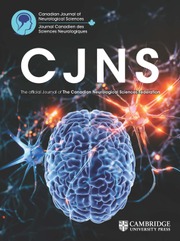No CrossRef data available.
Article contents
Clinical Neuropathology Conference: “Liquid Assets”
Published online by Cambridge University Press: 10 January 2025
Abstract
An abstract is not available for this content so a preview has been provided. Please use the Get access link above for information on how to access this content.
Keywords
- Type
- Clinical Neuropathological Conference
- Information
- Copyright
- © The Author(s), 2025. Published by Cambridge University Press on behalf of Canadian Neurological Sciences Federation
Footnotes
*
Contributed equally to this work.
References
Wang, Q, Wen, Z, Cao, Q. Risk of tuberculosis during infliximab therapy for inflammatory bowel disease, rheumatoid arthritis, and spondyloarthropathy: a meta-analysis. Exp Ther Med. 2016;12:1693–1704.CrossRefGoogle ScholarPubMed
Dahmus, J, Rosario, M, Clarke, K. Risk of lymphoma associated with anti-TNF therapy in patients with inflammatory bowel disease: implications for therapy. Clin Exp Gastroenterol. 2020;13:339–350.CrossRefGoogle ScholarPubMed
Stamatiades, GA, Ioannou, P, Petrikkos, G, Tsioutis, C. Fungal infections in patients with inflammatory bowel disease: a systematic review. Mycoses. 2018;61:366–376.CrossRefGoogle ScholarPubMed
Morís, G. Inflammatory bowel disease: an increased risk factor for neurologic complications. World J Gastroenterol. 2014;20:1228.CrossRefGoogle ScholarPubMed
Hu, J, Western, S, Kesari, S. Brainstem glioma in adults. Front Oncol. 2016;6:180.CrossRefGoogle ScholarPubMed
Yu, D, Han, G, Liu, H, Gao, L, Verma, V. Treatment of adult brainstem glioma with combined antiangiogenic therapy: a case report and literature review. Onco Targets Ther. 2019;12:1333–1339.CrossRefGoogle ScholarPubMed
Guzmán-De-Villoria, JA, Fernández-García, P, Ferreiro-Argüelles, C. Differential Diagnosis of T2 Hyperintense Brainstem Lesions: Part 1. Focal Lesions. Semin Ultrasound CT MR. 2010;31:246–259.CrossRefGoogle ScholarPubMed
WHO Classification of Tumours Editorial Board. World Health Organization classification of tumours of the central nervous system. 5th edn. Lyon: International Agency for Research on Cancer; 2021.Google Scholar
Dono, A, Takayasu, T, Ballester, LY, Esquenazi, Y. Adult diffuse midline gliomas: clinical, radiological, and genetic characteristics. J Clin Neurosci. 2020;82:1–8.CrossRefGoogle ScholarPubMed
Hoffman, LM, Veldhuijzen van Zanten, SE, Colditz, N, et al. Clinical, radiologic, pathologic, and molecular characteristics of long-term survivors of diffuse intrinsic pontine glioma (DIPG): a collaborative report from the international and european society for pediatric oncology DIPG registries. J Clin Oncol. 2018;36:1963–72.CrossRefGoogle ScholarPubMed
Buczkowicz, P, Bartels, U, Bouffet, E, Becher, O, Hawkins, C. Histopathological spectrum of paediatric diffuse intrinsic pontine glioma: diagnostic and therapeutic implications. Acta Neuropathol. 2014;128:573–581.CrossRefGoogle ScholarPubMed
Mattox, AK, Yan, H, Bettegowda, C. The potential of cerebrospinal fluid-based liquid biopsy approaches in CNS tumors. Neuro Oncol. 2019;21:1509–1518.CrossRefGoogle ScholarPubMed
Miller, AM, Shah, RH, Pentsova, EI, et al. Tracking tumour evolution in glioma through liquid biopsies of cerebrospinal fluid. Nature. 2019;565:654–658.CrossRefGoogle ScholarPubMed
Iser, F, Hinz, F, Hoffmann, DC, et al. Cerebrospinal fluid cfDNA sequencing for classification of central nervous system glioma. Clin Cancer Res. 2024;30:2974–85.Google ScholarPubMed
Friedman, JS, Hertz, CAJ, Karajannis, MA, Miller, AM. Tapping into the genome: the role of CSF ctDNA liquid biopsy in glioma. Neuro-Oncology Advances. 2022;4:ii33–ii40.CrossRefGoogle ScholarPubMed
Chai, R, An, S, Lin, H, et al. Sequencing of cerebrospinal fluid cell-free DNA facilitated early differential diagnosis of intramedullary spinal cord tumors. NPJ Precision Oncology. 2024;8:43.CrossRefGoogle ScholarPubMed
Fujioka, Y, Hata, N, Akagi, Y, et al. Molecular diagnosis of diffuse glioma using a chip-based digital PCR system to analyze IDH, TERT, and H3 mutations in the cerebrospinal fluid. J Neuro-ONCOL. 2021;152:47–54.CrossRefGoogle ScholarPubMed
Panditharatna, E, Kilburn, LB, Aboian, MS, et al. Clinically relevant and minimally invasive tumor surveillance of pediatric diffuse midline gliomas using patient-derived liquid biopsy. Clin Cancer Res. 2018;24:5850–9.CrossRefGoogle ScholarPubMed
Stallard, S, Savelieff, MG, Wierzbicki, K, et al. CSF H3F3A K27M circulating tumor DNA copy number quantifies tumor growth and in vitro treatment response. Acta neuropathologica communications. 2018;6:1–4.CrossRefGoogle ScholarPubMed
Mackay, A, Burford, A, Carvalho, D, et al. Integrated molecular meta-analysis of 1,000 pediatric high-grade and diffuse intrinsic pontine glioma. Cancer Cell. 2017;32:520–37.CrossRefGoogle ScholarPubMed
Werbrouck, C, Evangelista, CC, Lobón-Iglesias, MJ et al. TP53 pathway alterations drive radioresistance in diffuse intrinsic pontine gliomas (DIPG). Clin Cancer Res. 2019;25:6788–800.CrossRefGoogle ScholarPubMed
Jang, SW, Song, SW, Kim, YH, et al. Clinical features and prognosis of diffuse midline glioma: a series of 24 cases. Brain Tumor Res Treat. 2022;10:255–64.CrossRefGoogle ScholarPubMed
Majzner, RG, Ramakrishna, S, Yeom, KW, et al. GD2-CAR T cell therapy for H3K27M-mutated diffuse midline gliomas. Nature. 2022;603:934–41.CrossRefGoogle ScholarPubMed
Venneti, S, Kawakibi, AR, Ji, S, et al. Clinical efficacy of ONC201 in H3K27M-mutant diffuse midline gliomas is driven by disruption of integrated metabolic and epigenetic pathways. Ann Ny Acad Sci. 2023;13:2370–93.Google ScholarPubMed


